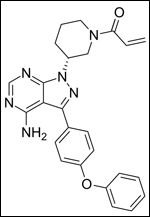ASH: Novel BTK Inhibitor PCI-32765 Shows Promise to Change the Paradigm for Treatment of CLL
Updated findings from a multicenter phase Ib/II clinical trial suggest that the novel Bruton’s tyrosine kinase (BTK) inhibitor PCI-32765 may be an important new targeted treatment approach for patients with chronic lymphocytic leukemia.
SAN DIEGO-Updated findings from a multicenter phase Ib/II clinical trial suggest that the novel Bruton’s tyrosine kinase (BTK) inhibitor PCI-32765 may be an important new targeted treatment approach for patients with chronic lymphocytic leukemia (CLL). “BTK is a central mediator of B-cell receptor signaling essential for normal B-cell development,” explained lead author Susan O’Brien, MD, professor in the department of leukemia at the University of Texas MD Anderson Cancer Center, Houston. This makes it a primary target for research on B-cell malignancies such as non-Hodgkin lymphoma (NHL).

Chemical structure of PCI-32765
PCI-32765, an orally-administered irreversible inhibitor of BTK, induces apoptosis and inhibits cellular migration and adhesion in malignant B-cells. An early analysis of the phase Ib/II study showed PCI-32765 to be “highly active and tolerable” in patients with CLL (Byrd, ASCO 2011). Longer term follow-up was presented by Dr. O’Brien.
Two cohorts of patients with relapsed or refractory (R/R) CLL/small lymphocytic lymphoma (SLL) were treated with PCI-32765 at doses of either 420 mg (n = 27) or 840 mg (n = 34) daily for 28-day cycles until they showed signs of disease progression. Patients in the 420 mg arm had a median of 3 prior treatment regimens, and those in the 840 mg had a median of 5. Nearly three-fourths (72%) of participating patients had at least one poor-risk molecular feature.
In the current analysis, researchers concluded that PCI-32765 was associated with high rates of 6-month progression-free survival (PFS) in patients with relapsed CLL. At 10 months follow-up, 70% percent of patients in the 420-mg treatment group achieved an objective response (OR) to therapy (previously reported as 48%), and 44% percent of patients in the 840 mg cohort achieved an OR at 6 months follow-up.
An additional 19% of the 420 mg cohort and 35% of the 840 mg cohort had a “nodal partial response” represented by a ≥ 50% reduction in lymph node size but with some lymph nodules persisting. The researchers emphasized that 82% of patients remain on treatment, whereas 8% have experienced progressive disease.
Two patients discontinued the trial because of adverse events, and 6 patients required a dose reduction. The most frequently reported adverse events were mild and included diarrhea, fatigue, nausea, and skin bruising.
Serious adverse events (SAEs), common among this immune-compromised patient population, occurred in 38% of patients, with 10% considered potentially related to treatment. The majority of patients also experienced a transient high lymphocyte count during the first 2 months of treatment, which resolved over time, another typical characteristic of treatment in this patient group.
“Our results suggest that PC-32765 has the potential to be highly effective and tolerable, and, more importantly, appears to be working well in patients with poor prognoses,” said Dr. O’Brien. “As we become better equipped to target specific cellular functions, it is our hope that therapies like PCI-32765 will become effective interventions to manage disease in patients with CLL.”
The investigators concluded that PCI-32765 is well tolerated with high rates of 6-month PFS in R/R CLL/ SLL. Phase III trials of PCI-32765 in CLL/ SLL are planned.
“One of the most exciting things about agents like PCI-32765 is that they are not myelosuppressive,” said Dr. O’Brien. “This is a big deal in CLL because one of the biggest problems we have with treatment is that all the treatments we have are chemo based and the biggest complication with practically every agent we have is myelosuppression and infection,” which are of special concern in patients with CLL who are already immunocompromised.
Newsletter
Stay up to date on recent advances in the multidisciplinary approach to cancer.